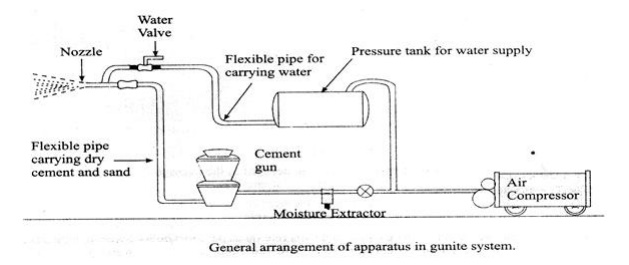Chapter: Civil : Repair and Rehabilitation of Structures : Techniques for Repair and Demolition
Gunite or Shotcrete
Gunite or Shotcrete
Gunite can be defined as mortar
conveyed through a hose and pneumatically projected at a high velocity on to a
surface. Recently the method has been further developed by the introduction of
small sized coarse aggregate into the mix deposited to obtain considerably
greater thickness in one operation and also to make the process economical by
reducing the cement content.
Normally
fresh material with zero slump can support itself without sagging or peeling
off.
The force of the jet impacting on
the surface compact the material. Sometimes use of set accelerators
to assist overhead placing is practiced. The newly developed 'Redi-set
cement' can
also be used for shotcreting process.
There is not much difference
guniting and shotcreting. Gunite was first used in the early 1900 and this
process is mostly used of pneumatically application of mortar of less
thickness, whereas shotcrete is a recent development on the similar principal
of guniting for achieving greater thickness with small coarse aggregates.
There are two different processes
in use, namely the 'Wet-mix' process and the 'dry-mix' process.
They dry mix process is more successful and generally used.
Dry-mix process
The dry mix process consists of a
number of stages and calls for some specialized plant. A typical plant set-up
is shown in Fig
The stages involved in the dry mix process is
given below :
(a) Cement
and sand are thoroughly mixed.

(b) The
cement/sand mixture is fed into a special air-pressurized mechanical feeder
termed as
'gun'.
(c) The mixture
is metered into the delivery hose by a feed wheel or distributor within the
gun.
(d) This
material is carried by compressed air through the delivery hose to a special
nozzle. The nozzle is fitted inside with a perforated manifold through which
water is sprayed under pressure and intimately mixed with the sand/cement jet.
(e) The wet
mortar is jetted from the nozzle at high velocity onto the surface to be
gunited.
The
Wet-mix Process
In the Wet-mix process the concrete is mixed with
water as for ordinary concrete before conveying through the delivery pipe line
to the nozzle, at which point it is jetted by compressed air, onto the work in
the same way, as that of dry mix process.
The wet-mix process has been generally discarded
in favors of the dry-mix-process, owing to the greater success of the latter.
The dry-mix methods make use of high velocity or
low velocity system. The high velocity gunite is produced by using a small
nozzle and a high air pressure to produce a high nozzle velocity of about 90 to
120 metres per second.
This results in exceptional good compaction. The lower
velocity gunite is produced using large diameter hose for large for large
output. The compunction will not be very high.
Advantages of Wet and Dry process
Some of the advantages and
disadvantages of the wet and dry processes is discussed below. Although it is possible
to obtain more accurate control of the water/cement ratio with the wet process
the fact that this ratio can be kept very low with the dry process largely
overcomes the objection of the lack of accurate control.
The difficulty of pumping
light-weight aggregate concrete makes dry process more suitable when this type
of aggregate is used. The dry process on the other hand, is vey sensitive to
the water content of the sand, too wet a sand causes difficulties through
blockade of the delivery pipeline, a difficulty which does not arise with the
wet process.
The lower water/cement ratio
obtained with the dry process probably accounts for the lesser creep and
greater durability of concrete produced in this way compared with concrete
deposited by the wet process, but air-entraining agents can be use to improve
the durability of concrete deposited by the latter means. Admixtures generally
can be used more easily with the wet process except for accelerators.
Pockets of lean mix and of
rebound can occur with the dry process. It is necessary for the nozzelman to
have an area where he can dump unsatisfactory shotcrete obtained when he is
adjusting the water supply or when he is having trouble with the equipment.
These troubles and the dust
hazard are less with the wet process, but wet process does not normally give
such a dense concrete as the dry process. Work can be continued in more windly
weather with the wet process than with the dry process. Owing to the high
capacities obtainable with concrete pumps, a higher rate of laying of concrete
can probably be achieved in the wet process than with the dry process.
Related Topics